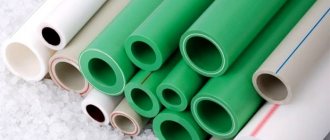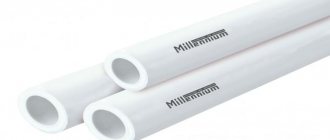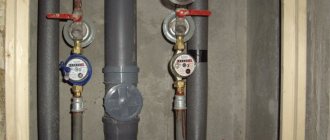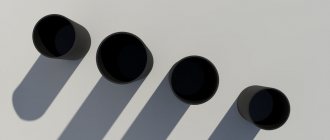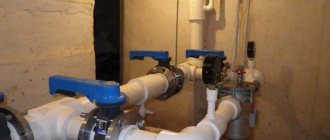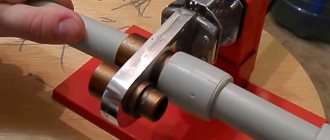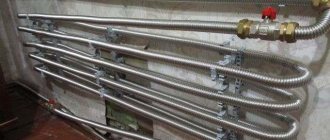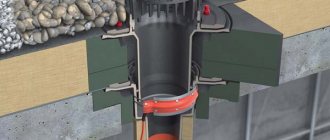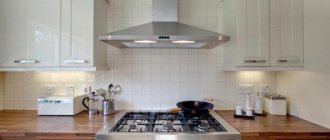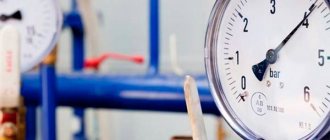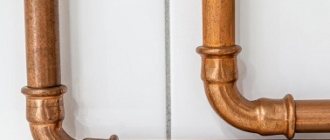Considering other parameters
Consumption rates according to SNiP described in the literature and on the Internet may differ from actual ones.
This indicator is influenced by a number of factors.
The main ones:
- The purpose of taking a shower. If you need to wash thoroughly, this will add 100-150% to the average norm. And in order to take a refreshing shower on a hot summer day, the equivalent of one 10-liter bucket is enough.
- Technical condition of plumbing. Now new shower sets are being produced with horns (watering cans), which allow you to hold elastic jets of water, regulate pressure and temperature automatically and at the same time significantly save fluid consumption. Old designs, for which regulatory data were written, provide less resource savings. If there is a defect in the equipment, there is a high probability that water will flow out of the system even when the tap is turned off.
- If you follow the recommendations of turning off the water flow during soaping, leaving the shower for a certain period and immediately after the end of the procedure, then these actions provide additional savings in liquid consumption.
Taking a bath
One of the most costly activities in terms of water consumption is taking a bath. Even to half fill a 150 cm long bathtub, you need about 150 liters of water. It's not hard to imagine how much water it would take to fill a full bath. On average, it takes about 300 liters to take a bath, which may indeed be worth the restored physical and mental strength, but it will never be an economical way to wash. However, taking a bath won't be a disaster if you don't take it every day.
APPENDIX 2
Mandatory
WATER AND WASTE WATER CONSUMPTIONS BY SANITARY DEVICES
Sanitary fixtures
| Second, in water consumption, l/s | Hourly consumption, l/h | Free head Hf, m | Wastewater flow from the device q 0 s , l/s | Minimum nominal bore diameters, mm | ||||||
| Total q 0 tot | Cold q 0 s | Hot q 0 h | Total q 0,hr tot | Cold q 0,hr c | Hot q 0,hr h | eyeliner | withdrawal | |||
| 1 | 2 | 3 | 4 | 5 | 6 | 7 | 8 | 9 | 10 | 11 |
| 1. Washbasin, washbasin with water tap | 0,1 | 0,1 | — | 30 | 30 | — | 2 | 0,15 | 10 | 32 |
| 2. The same, with a mixer | 0,12 | 0,09 | 0,09 | 60 | 40 | 40 | 2 | 0,15 | 10 | 32 |
| 3. Sink, inventory sink with water tap and laboratory water dispenser | 0,15 | 0,15 | 50 | 50 | 2 | 0,3 | 10 | 40 | ||
| 4. Sink (including laboratory) with mixer | 0,12 | 0,09 | 0,09 | 80 | 60 | 60 | 2 | 0,6 | 10 | 40 |
| 5. Sink (for catering establishments) with mixer | 0,3 | 0,2 | 0,2 | 500 | 220 | 280 | 2 | 0,6 | 15 | 50 |
| 6. Bathtub with mixer (including a common one for bathtubs and washbasin) | 0,25 | 0,18 | 0,18 | 300 | 200 | 200 | 3 | 0,8 | 10 | 40 |
| 7. Bath with hot water column and mixer | 0,22 | 0,22 | — | 300 | 300 | — | 3 | 1,1 | 15 | 40 |
| 8. Medical bathtub with mixer nominal diameter, mm: | ||||||||||
| 20 | 0,4 | 0,3 | 0,3 | 700 | 460 | 460 | 5 | 2,3 | 20 | 50 |
| 25 | 0,6 | 0,4 | 0,4 | 750 | 500 | 500 | 5 | 3 | 25 | 75 |
| 32 | 1,4 | 1 | 1 | 1060 | 710 | 710 | 5 | 3 | 32 | 75 |
| 9. Foot bath with mixer | 0,1 | 0,07 | 0,07 | 220 | 165 | 165 | 3 | 0,5 | 10 | 40 |
| 10. Shower cabin with shallow shower tray and mixer tap | 0,12 | 0,09 | 0,09 | 100 | 60 | 60 | 3 | 0,2 | 10 | 40 |
| 11. Shower cabin with deep shower tray and mixer tap | 0,12 | 0,09 | 0,09 | 115 | 80 | 80 | 3 | 0,6 | 10 | 40 |
| 12. Shower in a group installation with mixer | 0,2 | 0,14 | 0,14 | 500 | 270 | 230 | 3 | 0,2 | 10 | 50 |
| 13. Hygienic shower (bidet) with mixer and aerator | 0,08 | 0,05 | 0,05 | 75 | 54 | 54 | 5 | 0,15 | 10 | 32 |
| 14. Bottom rising shower | 0,3 | 0,2 | 0,2 | 650 | 430 | 430 | 5 | 0,3 | 15 | 40 |
| 15. Column in a soap dish with a cold or hot water tap | 0,4 | 0,4 | — | 1000 | 1000 | — | 2 | 0,4 | 20 | — |
| 16. Toilet with flush cistern | 0,1 | 0,1 | — | 83 | 83 | — | 2 | 1,6 | 8 | 85 |
| 17. Toilet with flush tap | 1,4 | 1,4 | — | 81 | 81 | — | 4 | 1,4 | — | 85 |
| 18. Urinal | 0,035 | 0,035 | — | 36 | 36 | — | 2 | 0,1 | 10 | 40 |
| 19. Urinal with semi-automatic flush tap | 0,2 | 0,2 | 36 | 36 | 3 | 0,2 | 15 | 40 | ||
| 20. Drinking fountain | 0,04 | 0,04 | — | 72 | 72 | — | 2 | 0,05 | 10 | 25 |
| 21. Watering tap | 0,3 | 0,3 | 0,2 | 1080 | 1080 | 720 | 2 | 0,3 | 15 | — |
| 22. Ladder with nominal diameter, mm: | ||||||||||
| 50 | — | — | — | — | — | — | — | 0,7 | — | 50 |
| 100 | — | — | — | — | — | — | — | 2,1 | — | 100 |
Notes: 1. When installing aerators on water taps and mixers, the free pressure in the connections should be at least 5 m.
2. The flow rate of wastewater discharged by drains should be determined by calculation in accordance with clause 3.4 and taken no more than those indicated in the table.
3. For water supply systems, when using collector connections made of plastic pipes to washbasins, sinks, sinks, bathtub faucets and washbasins, shower cabins, bidets, toilets with a flush tank, urinals, drinking fountains, it is allowed to use pipes with a diameter of 12x2 mm.
“Amendment” in calculations in the presence of “smart” devices for saving
The notes to the SNiP tables separately stipulate the rule for installing aerators. If they are present on water-folding mixers, the free pressure is assumed to be at least 5 m. However, an “adjustment” should also be made for the total water flow, since the water flow limiter on the tap, thanks to its design, can reduce the volume of water consumption by 7-15% (depending on the aerator model and consumption mode).
Savings occur by limiting the flow, which, however, does not affect the comfort of using it for domestic purposes, since the sensation of volume and density of the stream is created by small air bubbles mixing with water. This aeration effect is achieved due to the design of various faucet nozzles, inside of which there are dissecting meshes and turbines that create turbulence. And the effectiveness of these devices depends on the number and shape of structural elements.
For example, London student Simin Qiu managed to combine a design approach with saving water resources in the “Swirl Faucet” mixer. Two turbines are already built into the design of the device, which twist the hydraulic flow in a spiral. By switching from one nozzle to another, the owner of the device can “twist” the stream in the form of a “drill”, “DNA molecule” or “mesh spring”.
A beautiful, but discharged jet saves about 15% of its resource compared to a solid monojet.
Long-term experiments and comparison of meter readings demonstrate savings of 7-10% when installing a cheaper WaterSave saver https://water-save.com/. The comparison of economic efficiency here is made for one plumbing fixture, which is used in free flow mode. The savings are slightly less than in the previous case, but it is possible to change the direction of the jet, and there is also a function for changing the spray mode.
The effectiveness of the sprayer for saving water per tap is that thanks to it, a thin stream of water, breaking into dozens of micro-jets, covers the irrigation area sufficient for comfortable use. The area of contact of drops with food or soapy hands is larger, which means the result is more noticeable.
However, in all the described cases, savings are possible with running water consumption, since if necessary, fill a 100-liter bath, the water flow, even with aerators, will still be 100 liters without them.
Another innovation - a smart faucet for saving water also significantly affects preliminary calculations. One of the smart device models, Dial W from designer Eun ji Byeon, looks like an ordinary faucet with an unusual switch. Instead of a valve, it has a disk similar to an old telephone disk, but, unlike a telephone, there is no spring mechanism that returns it to its original position after rotation. By selecting a value and turning the dial, the water consumption mode is set. The dial has 4 “windows” corresponding to 4 water flow positions: 5 seconds, 10, 15 and “unlimited mode”. The values on each of them are the time after which the water automatically turns off.
The efficiency of another Greenbell “bell” nozzle, which according to the manufacturers is 80%, is calculated mathematically, based on the fact that during any water procedure, only 20% of the water is used for its intended purpose, and the rest flows away “idle”.
The “bell” nozzle stops the hydroflow, and to resume it, you need to swing the “tongue” of the device in any direction.
However, “smart” devices act not only by limiting, but also by optimizing the process and reducing the preparation time for water procedures. For example, there are sensor attachments that turn on only when an object is placed under them (hands, food, dishes), immediately releasing a flow of the desired temperature. As a rule, such devices already have an aerator.
Why has there been a massive need among consumers to save water consumption? Not so long ago, we could turn on the tap and calmly get distracted by our own affairs: open the door, answer the phone, go to another room, etc. Now this is not the case; the price of utilities has increased several times. Prices for electricity, water, gas, concierge - it feels like our house is robbing us. But fortunately, there is a way out of every situation and with the right approach you can save a lot of money.
And yet, how to save on water? What methods should be used? There are a lot of answers to this question; almost every tenant uses some of his own methods. Everyone understands that paying for water is becoming more and more expensive every year and something needs to be done about it.
Indeed, who would want to give away extra money that goes down the drain without a trace (literally and figuratively), when you can use a mixer, the water consumption of which is much more economical than that of traditional taps. Most often, people use regular meters to see how much water they have used in a month, but it would be more effective to pay attention to various regulators, “smart faucets”, etc.
When saving water, it is not at all necessary to push yourself into strict limits: wash in the shower once a week or, for example, not wash fruit. You can use, for example, an automatic mixer, or one of the types of regulators.
It is worth clarifying that the “everyone’s favorite” GOST significantly overestimates the required volume of water per person. State standards state that water consumption per person is 12 liters per minute, while generally accepted standards recognize that 5-6 liters per minute is more than sufficient for one person. Regulators and special mixers will help reduce water to this level.
Below we will look in more detail at how such devices can help us save water.
Regulators
As mentioned above, regulators are one of the most effective ways to save water. Such a device automatically reduces the pressure of the liquid, adjusting the stream at the optimal level for normal household needs. As a result, water consumption is reduced and money savings are increased.
Such a device should be chosen based on the individual preferences of the client, since there are different types of devices that differ in their characteristics:
- aerator made of plastic - can be placed in a regular metal case. Adjusting the water flow in the mixer using this device allows you to reduce the consumption of water to a level of two to nine liters of water per minute.
- Vandal-proof regulator - the design of such a regulator is similar to other similar devices, but differs in simpler installation. It requires no additional tools or wrench. Just like with the first copy, water consumption is reduced to 2 - 9 liters of water per minute.
- Built-in regulator - distinguished by a special thread, which is located both inside and outside. The structure itself consists of a medium-sized metal frame, an O-ring and an aerator. With the help of such a regulator, fluid flow is reduced to 2 - 8 liters per minute.
Advantages and disadvantages of regulators
When reading various advertising articles about the possibility of saving water using regulators, a person does not always trust the information received. But in fact, this device still allows you to reduce consumption, which significantly saves the consumer’s financial resources. In addition, these plumbing devices have some advantages that you should also pay attention to. Among them, experts highlight the following positive qualities:
- Regulators are able to significantly reduce water pressure, as a result of which the noise of the liquid flow becomes less significant.
- Installing the regulator is quite simple, which means you can install it yourself without the help of a plumber. The technique for carrying out this work is clear even on an intuitive level, but at the same time, each device comes with special instructions that explain how to attach it to the tap.
- There is a wide range of prices for different types of regulators. That is why each person can purchase exactly the device that best suits him in terms of parameters such as cost and quality. The price can be within one and a half hundred rubles or over one and a half thousand rubles.
When talking about the advantages of any devices, including water pressure regulators, one cannot help but remember their disadvantages. Neither are as follows:
- Short service life. This is primarily due not to the reliability of the design, but to the quality of the water that enters people’s taps. It may contain many additives and impurities. Budget models of regulators last only 0.5 years, while more expensive ones last up to 3 years. The filters inside these devices are the first to suffer.
- Increasing the duration of filling containers with water. Due to the fact that the water pressure decreases, the kettle or mug becomes full over a longer period of time.
- Not all regulators are suitable for certain types of mixers. That is why it is best to check what type of thread you need to purchase the device with before purchasing.
Despite all the disadvantages, the advantages of regulators are still significant and significant. Therefore, this type of device for saving water consumption is very popular today.
Automatic faucets
Such devices have a special touch sensor. As soon as you bring your hand closer to the mixer, the water immediately turns on, and as soon as you move it away, it turns off. It would seem, why can’t I turn the water on and off myself? But it's not that simple.
According to experts, water consumption using such mixers can be reduced by up to 20-40%. Let's give a few examples from everyday life. Imagine that you are washing dishes in the kitchen. While you are washing dishes, you spill a certain amount of liquid, and therefore the water consumption when you take a new plate or mug increases.
Another example, you decide to wash your face in the morning and you at least need to brush your teeth. While you brush your teeth, water just spills down the drain. Now imagine the water consumption in the morning if you still needed to shave, wash your hair, etc.
Advantages of automatic faucets
In addition to significant water savings, automatic faucets have a number of huge advantages. So, these include:
— Hygiene – you may have noticed such faucets many times in shopping centers. Installing such faucets there seems like a really good decision if you think about how many people pass through the toilets in the shopping center. But at home this option will not be superfluous, since when you come from the street, before washing your hands, you need to turn on the tap. After you washed your hands, you touched the same dirty tap only with wet hands.
— Convenience – sometimes turning the tap is simply inconvenient: greasy or soapy hands, rush, etc.
— Durability – the internal elements of faucets wear out over time due to constant switching and rotation. This won't happen with this faucet, so you don't even have to touch it.
Having a completely independent source of water is a big plus for any residential building. However, water coming from a log or well (and even more so from an open natural source) must necessarily be subject to special preparation for safe use - filtration and purification. This is a rather complex multi-stage process that requires the installation of a whole cascade of modules for various purposes.
When choosing a filtration system, it must be assumed that it must be able to cope with the possible water consumption in the house. This means that it is necessary to find out this operational parameter. And a calculator for calculating peak water consumption for choosing a filtration system will help you figure out this problem.
The necessary explanations for performing the calculations are located below the calculator.
Internal water supply and sewerage of buildings.SNiP 2.04.01-85*.
